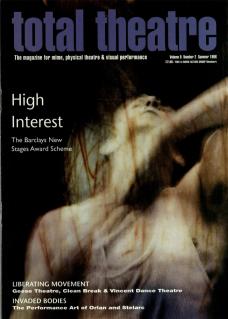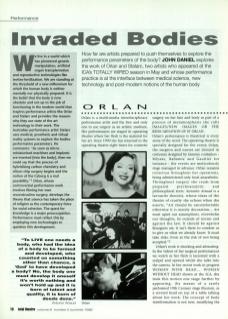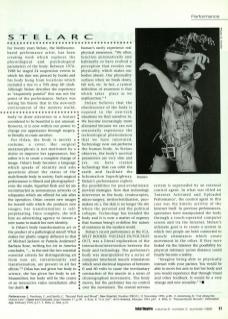We live in a world which has pioneered genetic manipulation, artificial organ transplantation, and reproductive technologies like in-vitro-fertilisation. We are standing at the threshold of a new millennium for which the human body is neither mentally nor physically prepared. It is the belief that the body is now obsolete and not up to the job of functioning in the modern world that inspires performance artists like Orlan and Stelarc and provides the reasons why they use state of the art technology in their work. The Australian performance artist Stelarc uses medical, prosthetic and virtual reality systems to explore the body’s performative parameters. He comments: ‘As soon as micro-miniaturised machines and implants are inserted [into the body], then we could say that the process of hybridising carbon chemistry and silicon chip surgery begins and the notion of the Cyborg is a real possibility.’ Orlan, whose controversial performance work involves filming her own reconstructive surgery, develops the theory that science has taken the place of religion as the contemporary force for social cohesion. The quest for knowledge is a major preoccupation. Performance must reflect this by employing new technologies to question this development.
‘To LIVE one needs a body, who had the idea of a body to be formed and developed, who counted on something other than chance, a "God” to have developed a body? No, the body one must develop it oneself it's worth nothing and won't hold up and it is born of talent and quality, it is born of deeds done.’ – Antonin Artaud
Orlan
Orlan is a multimedia interdisciplinary performance artist and the first and only one to use surgery as an artistic medium. Her performances are staged in operating theatres where her flesh is the material for her art. Since 1990 she has returned to the operating theatre eight times for cosmetic surgery on her face and body as part of a process of metamorphosis she calls Images/New Images or The Reincarnation of St Orlan.
Orlan's performance is theatrical is every sense of the word. The operating theatre is specially designed for the event; Orlan, the surgeon and nurses are dressed in costumes designed by famous couturiers – Miyake, Rabanne and Gaultier for instance – and the events are meticulously stage managed in advance. Orlan remains conscious throughout her operations, being administered only local anaesthetic. Throughout surgery she reads from prepared psychoanalytic and philosophical texts. Antonin Artaud is a favourite theorist, whose ideas of the theatre of cruelty she echoes when she asserts, ‘Art should be uncomfortable otherwise it is merely decoration... Art must upset our assumptions, overwhelm our thoughts, be outside of norms and against the law. It should be against Bourgeois art; it isn't there to comfort or to give us what we already know. It must take risks. Even at the risk of not being accepted.’
Orlan's work is shocking and alienating. In the videos of her surgical performances we watch as her flesh is lacerated with a scalpel and opened whilst she talks into the camera. In her recent work in progress Woman with Head... Woman Without Head shown at the ICA, she took this notion one stage further by appearing (by means of a rarely performed 19th Century stage illusion) as a severed head on top of a table talking about her work. The concept of body transformation is not new, modifying the body to draw attention to a feature considered to be beautiful is not unusual. However, it is now within our power to change our appearance through surgery, to literally recreate ourselves.
For Orlan, the body is merely a costume, a cover. Her surgical metamorphosis is not motivated by a desire to improve her appearance, but rather it is to create a complete change of image. Orlan's body becomes a language which speaks of identity and asks questions about the status of the male/female body in society. Each surgical performance is filmed and photographed – even the swabs, liquefied flesh and fat are reconstructed as autonomous artworks or reliquaries which are offered for sale after the operation. Orlan creates new images for herself with which she produces new images; her transformation is self-perpetuating. Once complete, she will hire an advertising agency to invent a new name to match her new identity.
Is Orlan's body transformation art or the product of a pathological mind? What makes her plastic surgery different to that of Michael Jackson or Pamela Anderson? Barbara Rose, writing for Art in America concludes, ‘... in the end the two essential essential criteria for distinguishing art from non art, intentionality and transformation, are present in all her efforts.’ Orlan has not given her body to science, she has given her body to art. Mummified, her body will be the centre of an interactive video installation after her death.
Stelarc
For twenty years Stelarc, the Melbourne-based performance artist, has been creating work which explores the physiological and psychological parameters of the body. Between 1976-1988 he staged 24 suspension events in which his skin was pierced by hooks and his body hung from locations which included a tree and a 70ft deep lift shaft. Although Stelarc describes the experience as ‘exquisitely painful’ this was not the point of the performance. Stelarc was testing his theory that in the new-tech environment of the modern world, humans rarely experience real physical awareness. ‘We often function automatically and habitually so have evolved a perception that recedes our physicality, which makes our bodies absent. Our physicality surfaces when we break down, fall sick, etc. In fact, a cynical definition of awareness is that which takes place as we malfunction.’
Stelarc believes that the obsolescence of the body is exposed in the new-tech situations we find ourselves in. We become increasingly more alienated because we cannot sensorially experience the technological phenomenon that we have innovated. Technology now out-performs the human body. As Stelarc observes, the body's survival parameters are very slim and yet, we have created technology that can orbit the earth and facilitate the Information Superhighway. Stelarc's performances explore the possibilities for post-evolutionary survival strategies. Now that technology intervenes in the body (endoscopies, micro-surgery, in-vitro-fertilisation, pacemakers etc.), the skin is no longer the site where the personal and the political collapse. Technology has invaded the body and it is now a matter of urgency that human beings redefine the nature of existence in the modern world.
Stelarc's recent performance at the ICA, Split Bodies: Voltage In / Voltage Out, was a literal exploration of the interaction/intervention between the body and technology. The performer's body was manipulated by a series of computer interfaced muscle stimulators which send electrical impulses of between 0 and 60 volts to cause the involuntary contraction of the muscle in a series of choreographed movements. The body moves, but the performer has no control over the movement. The central nervous system is superseded by an external control agent. In what was titled an 'Internet Activated and Uploaded Performance', the control agent in this case was the kinetic activity of the Internet itself. In previous performances, spectators have manipulated the body through a touch-operated computer screen and via the Internet. Stelarc's ultimate goal is to create a system in which two people are both connected to muscle stimulators which create movement in the other. If they were linked via the Internet the possibility for physical intimacy across distance could finally become a reality.
‘Imagine being able to physically interact with your partner. You would be able to move her arm to feel her body and you would experience that through visual and other feedback. It would be a very strange and new sexuality.’


